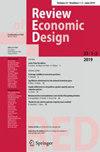将信息设计游戏映射到全付费拍卖
IF 0.5
4区 经济学
Q4 ECONOMICS
Review of Economic Design
Pub Date : 2025-01-01
Epub Date: 2023-07-20
DOI:10.1007/s10058-023-00334-w
引用次数: 0
摘要
我正式建立了具有多个发送者的信息设计类游戏与全付费拍卖类游戏之间的映射关系。我完全描述了这种映射,并展示了如何使用它来找到信息设计游戏中的平衡。这种映射允许对后一类博弈中的平衡进行直接的比较静态分析。我用它来研究破局规则对后发者分配和接收者收益的影响。本文章由计算机程序翻译,如有差异,请以英文原文为准。

Mapping an information design game into an all-pay auction.
I formally establish the existence of a mapping between a class of information design games with multiple senders and a class of all-pay auctions. I fully characterize this mapping and show how to use it to find equilibria in the information design game. The mapping allows for a straightforward comparative statics analysis of equilibria in the latter class of games. I use it to study the effect of the tie-breaking rule on the distributions of posteriors and the receiver's payoff.
求助全文
通过发布文献求助,成功后即可免费获取论文全文。
去求助
来源期刊

Review of Economic Design
ECONOMICS-
CiteScore
0.80
自引率
28.60%
发文量
37
期刊介绍:
Review of Economic Design comprises the creative art and science of inventing, analyzing and testing economic as well as social and political institutions and mechanisms aimed at achieving individual objectives and social goals. In this age of Economic Design, the accumulated traditions and wealth of knowledge in normative and positive economics and the strategic analysis of game theory are applied with novel ideas in the creative tasks of designing and assembling diverse legal-economic instruments. These include constitutions and other assignments of rights, mechanisms for allocation or regulation, tax and incentive schemes, contract forms, voting and other choice aggregation procedures, markets, auctions, organizational forms, such as partnerships, together with supporting membership and other property rights, and information systems. These designs, the methods of analysis used in their scrutiny, as well as the mathematical techniques and empirical knowledge they employ, along with comparative assessments of the performance of known economic systems and implemented designs, all of these form natural components of the subject matter of Economic Design.
Officially cited as: Rev Econ Design
 求助内容:
求助内容: 应助结果提醒方式:
应助结果提醒方式:


